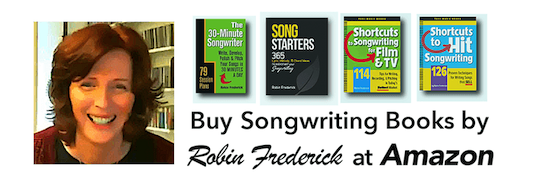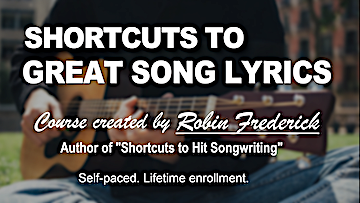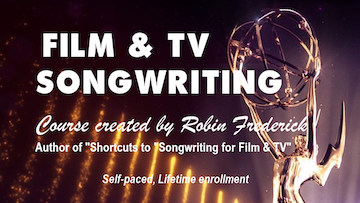Here’s a successful Singer-Songwriter song with simple production and an honest, emotionally moving lyric. Alexi Murdoch has sold over 50,000 CDs through CD Baby making him one of their biggest sellers of all time. He self-releases his music and has turned down several offers from major labels. Most of his sales came as a result of the film & TV uses of his songs.
You’ve probably heard the song “All My Days” without realizing it. It’s featured in a commercial for Sprint and has also been used in several TV series, including CSI, Scrubs, and The OC. Let’s take a look at why this simple, acoustic song is so successful.
SONG GUIDE
“All My Days” – Alexi Murdoch
Songwriter: Alexi Murdoch
TECHNIQUES TO HEAR AND TRY:
• Use a Folk song structure with a refrain.
• Show don’t tell listeners how you feel.
• Try a simple melody phrase pattern.
Listen to the song. Read the lyrics.
Watch the video on YouTube.
Read the lyrics.
Shortcut # refers to my book “Shortcuts to Songwriting for Film & TV.”

GENRE
(What is a genre? Watch this video.)
The genre is Indie Singer-Songwriter, a style the film and TV market absolutely loves! There are many similarities to English folk revival and folk/rock artists such as Nick Drake, Sandy Denny, and John Martyn. The simplicity of the recording and intimate vocal style both owe much to the work of Nick Drake, an artist Murdoch has cited as an influence. Drake is another artist whose work was introduced to a broad audience through TV commercials and films.
SONG STRUCTURE
The structure is: VERSE / VERSE / VERSE / VERSE / TAG out.
This is a traditional folk song structure. The song doesn’t have a fully-developed chorus. Instead, it relies on a memorable, repeated refrain line—”All of my days”—after the first and third lines of each verse to provide the hook.
Well, I have been searching all of my days,
All of my days
Many a road, you know I’ve been walking on
All of my days
Another repeated line at the end of each verse (“As the days keep turning into night”) also anchors the listener in the song and could be considered a secondary hook.
A “tag” simply refers to a line at the very end of the song that’s repeated several times, sometimes with variations (as you can hear in this song). The tag is often the refrain line, but not always. Music editors like to use a tag at the end of a scene because it’s often the most emotional part of the song. You can hear tags at the end of “Poison & Wine” by The Civil Wars, “Keep Breathing” by Ingrid Michaelson, and “Never Say Never” by The Fray, all songs that have been very successful in film & TV.
BONUS FILM & TV SONG TIP: For film and TV, be sure to wrap up your song with a well-defined ending (a “button ending”). Let the instruments ring out naturally on a final note, chord, or percussion hit. Fade outs are okay for radio but a button ending is much more effective at the end of a TV scene (“FTV” Shortcut #77).
LYRICS
The lyrics are conversational and emotionally honest. It almost sounds like the singer thinking out loud. This plain, everyday speech style fits well with the melody, the folk guitar picking, and straight-ahead vocal. A very flowery or literary lyric might sound out of place, at odds with the music. You always want your lyric and music to work together, reinforcing a single effect for the listener.
In the second verse, Murdoch uses imagery (“Watch the sky breaking on the promise we made / All of this rain…”) to give the listener a mental picture of the emotions he’s feeling. Then, in the third verse, he expresses the emotion physically (“I cried aloud, I shook my hands.”) Both of these techniques work well to get listeners to feel what the singer is feeling. (You can read more about expressing emotion in your lyrics in “FTV” Shortcuts #52 & #53.)
Try these techniques in your own lyrics. You don’t have to go overboard in a song like this; just sprinkle images and the physical expression of an emotion here and there in your song.


MELODY / CHORDS
The guitar picking is intricate and steady while the melody floats over the top, creating a dreamy feel that still manages to convey a sense of energy. (Nick Drake took this idea even further. Listen to tracks like “‘Cello Song” and “Hazy Jane I” by Nick Drake to hear how he handles it.)
Murdoch varies the line lengths of the melody to sustain interest: The first line is long, the second line shorter, then he repeats the pattern. After that, he goes to a new pattern (“And I’ve been trying to find…”), repeats it, and wraps up by picking up the pace a little. (“As the days keep turning into night.”) It’s a simple but well structured melody and the variation in line lengths keeps it interesting.
PRODUCTION
The arrangement features a slow dynamic build created by adding instruments as the song develops. A basic arrangement with featured vocal like this one appeals to the film & TV market. It stays out of the way of dialogue while adding an intimate, immediate, emotional feel to a scene. It’s inexpensive to record, allowing you to create a steady stream of new material to pitch to this market.
Think about a bare bones production like this for your own songs. You can add a subtle build by adding bass, light percussion, and/or additional guitars as the song moves forward. If you’re working in the Rock genre, consider recording “unplugged” versions of your songs! (“FTV” Shortcut #75)
VOCAL: Notice that the vocal is clearly heard at all times, but it is far from perfect. The pitch is not always exact; the singer sounds as if he’s talking to you rather than making a real effort to sing. This type of vocal works very well for film & TV. The singer ends up sounding like an actor in the scene, not someone who’s trying hard to hit that dazzling high note.
For the Film & TV market, it’s not about dazzle (and it’s definitely not about auto-tune); it’s about honest emotion. If you’re concerned about your vocals, try taking a few acting and singing lessons. Whatever you do, don’t try to hide your voice behind the instruments. (For more on vocals for Film & TV, read “FTV” Shortcuts #79 & #80.)
TRY IT NOW
Learn to play and sing this song. If you don’t play an instrument, just sing along with the recorded version to get a feel for how the lyrics sit in the melody and chord changes.
See how this song was used in the Sprint ad.
You’ll find basic piano chords here. The guitar part is intricate and unless you’re a big Nick Drake fan, you might not want to spend the time to master it. Just use the piano chords and strum along.
